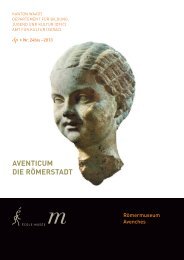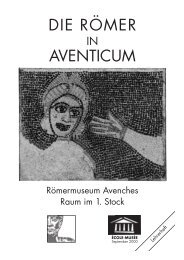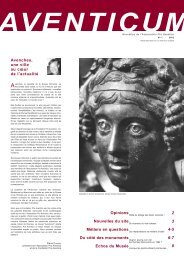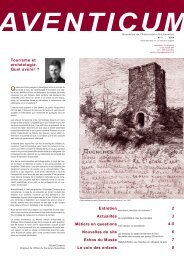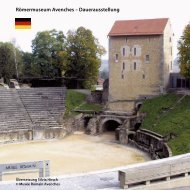Avenches – Roman Museum – Permanent Exhibition
Avenches – Roman Museum – Permanent Exhibition
Avenches – Roman Museum – Permanent Exhibition
You also want an ePaper? Increase the reach of your titles
YUMPU automatically turns print PDFs into web optimized ePapers that Google loves.
Ground Floor Miscellaneous<br />
24. Marble inscription in honour of [---] dius Flavus<br />
Discovered in insula 40, at the edge of the forum.<br />
Last quarter of the 1st century AD. Catalogue of inscriptions no. 1.<br />
25. Dedication in honour of Septimius Severus<br />
Discovered in insula 40, at the edge of the forum.<br />
AD 193-211. Catalogue of inscriptions no. 8.<br />
27. Inscription on mosaic adorning a semi-public building (1)<br />
Discovered in insula 29, next to the forum.<br />
Early 3rd century AD. Catalogue of inscriptions no. 19. Catalogue of mosaics no. 2.<br />
Miscellaneous<br />
28. Mosaic depicting Hercules and Antaeus (2)<br />
The tessellated floor consists of a series of pictures with the central laurel-framed image<br />
representing the fight between Hercules and Antaeus. Hunting and animal fight scenes<br />
are depicted in the centre, at each side of the main medallion.<br />
Antaeus was an African king, who drew his enormous strength from the earth and had<br />
to touch soil in order to be able to defeat his enemies. When Hercules was threatened by<br />
Antaeus, they began to wrestle; Hercules grabbed his opponent by the shoulders and lifted<br />
him up so that he could not renew his strength, and then he squashed and destroyed him.<br />
Here, Hercules is wearing a wreath and is thus depicted as a triumphant athlete.<br />
The corner squares show people that look like wrestlers because of their broad<br />
shoulders, muscular chests and thick necks. They are wearing wreathes made of leaves<br />
similar to that of Hercules. They are quite obviously victorious wrestlers.<br />
All the figurative motifs combined convey an image of triumph of bodily strength.<br />
Original dimensions: 5 m by 4.5 m. Private house situated in insula 59.<br />
Second quarter of the 3rd century AD. Catalogue of mosaics no. 20.<br />
29. Mosaic depicting gladiators<br />
This almost square piece of tessellated floor decorated the centre of a room, perhaps<br />
a dining room with three beds arranged in a U-shape (triclinium) along the walls.<br />
The geometric design is conceived in such a way that ones attention is drawn to the<br />
centrepiece. The badly damaged central scene depicts two fighting gladiators. While only<br />
their legs are preserved, they are easily recognised as gladiators because of the coloured<br />
bands tied around their knees indicating which troupe they were part of.<br />
Original dimensions: 2 m by 2.5 m. Northern suburb, private house situated north of<br />
insula 5.<br />
Second half of the 2nd century AD. Catalogue of mosaics no. 5.<br />
30. Limestone relief with head of the god Sol<br />
The <strong>Roman</strong> representations of this god are inspired by the Hellenistic iconography of Helios.<br />
This relief may have belonged to a large bust placed in the centre of the gable of a building.<br />
Probably from insula 19. Late 1st century AD.<br />
1<br />
2<br />
19<br />
Ground Floor



